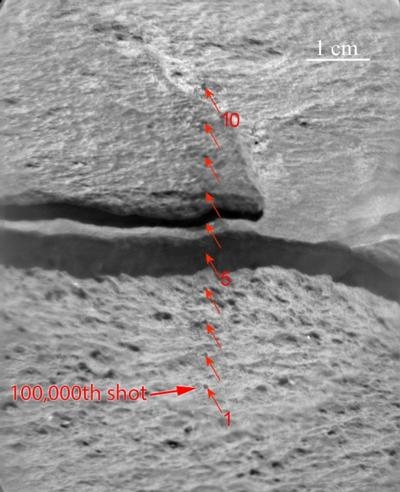Sun, Dec 15, 2013
Beam Checks Chemical Elements In Rocks And Soils
NASA's Curiosity Mars rover has passed the milestone of 100,000 shots fired by its laser. It uses the laser as one way to check which chemical elements are in rocks and soils. The 100,000th shot was one of a series of 300 to investigate 10 locations on a rock called "Ithaca" in late October, at a distance of 13 feet, 3 inches (4.04 meters) from the laser and telescope on rover's mast. The Chemistry and Camera instrument (ChemCam) uses the infrared laser to excite material in a pinhead-size spot on the target into a glowing, ionized gas, called plasma. ChemCam observes that spark with the telescope and analyzes the spectrum of light to identify elements in the target.

"Passing 100,000 laser shots is terribly exciting and is providing a remarkable set of chemical data for Mars," said ChemCam co-investigator Horton Newsom of the University of New Mexico, Albuquerque.
As of the start of December, ChemCam has fired its laser on Mars more than 102,000 times, at more than 420 rock or soil targets. Virtually every shot yields a spectrum of data returned to Earth. Most targets get zapped at several points with 30 laser pulses at each point. The instrument has also returned more than 1,600 images taken by its remote micro-imager camera.
An international team of scientists and students is mining information from ChemCam to document the diversity or materials on the surface inside Mars' Gale Crater and the geological processes that formed them. "These materials include dust, wind-blown soil, water-lain sediments derived from the crater rim, veins of sulfates and igneous rocks that may be ejecta from other parts of Mars," Newsom said.
Each pulse delivers more than a million watts of power for about five one-billionths of a second. The technique used by ChemCam, called laser-induced breakdown spectroscopy, has been used to assess composition of targets in other extreme environments, such as inside nuclear reactors and on the sea floor. Experimental applications have included environmental monitoring and cancer detection. NASA's Mars Science Laboratory Project, using the Curiosity rover, is the first mission to use it on another planet.
(NASA image)
More News
Homing [ICAO] The procedure of using the direction-finding equipment of one radio station with the emission of another radio station, where at least one of the stations is mobile, >[...]
Aero Linx: European Regions Airline Association (ERA) The European Regions Airline Association (ERA) represents a diverse membership of over 50 airlines and more than 150 associate>[...]
A Few Questions AND Answers To Help You Get MORE Out of ANN! 1) I forgot my password. How do I find it? 1) Easy... click here and give us your e-mail address--we'll send it to you >[...]
While On Short Final, About 300 Ft, The Pilot Performed A Forced Landing Near Trees On September 7, 2025, about 0932 eastern daylight time, a CubCrafters Carbon Cub EX airplane, N4>[...]
Severe Icing The rate of ice accumulation is such that ice protection systems fail to remove the accumulation of ice and ice accumulates in locations not normally prone to icing, s>[...]
 ANN's Daily Aero-Term (10.13.25): Homing [ICAO]
ANN's Daily Aero-Term (10.13.25): Homing [ICAO] ANN's Daily Aero-Linx (10.13.25)
ANN's Daily Aero-Linx (10.13.25) ANN FAQ: Q&A 101
ANN FAQ: Q&A 101 NTSB Prelim: CubCrafters Carbon Cub
NTSB Prelim: CubCrafters Carbon Cub ANN's Daily Aero-Term (10.14.25): Severe Icing
ANN's Daily Aero-Term (10.14.25): Severe Icing



